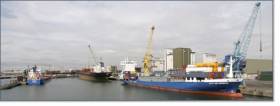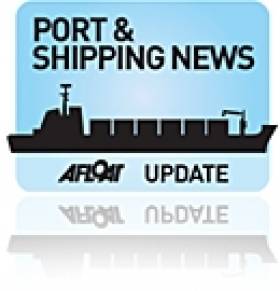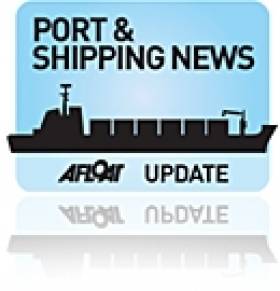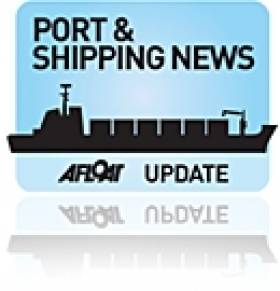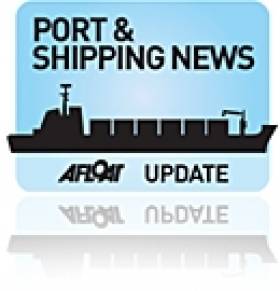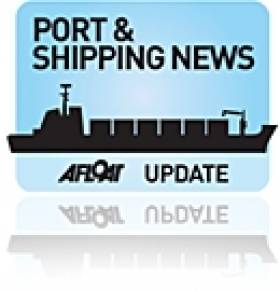Displaying items by tag: IMDO Weekly Review
IMDO Review: Big Response to Dublin Bay Dumping, EU Agree TEN-T, UK Concerns on Brexit & More
#IMDOreview - The Irish Maritime Development Office (IMDO) latest Weekly Market Review has among the following stories below.
Irish Maritime News: The Environmental Protection Agency (EPA) received a record number of submissions in relation to Dublin Port's Dumping Plan as reported on Afloat.ie following the port's most recent application to dump spoil in Dublin Bay.
Global Maritime News: E.U Ministers Agree to Implement TEN-T - The EU transport ministers convened at the first day of the TEN-T Days in the Van Nelle Factory in Rotterdam on Tuesday of this week.They discussed the process of implementing the Trans-European Transport Network: new challenges and opportunities, new technologies and mobility patterns for passengers, as well as digitalization and automation of freight transport.
Leaders of the U.K Shipping Industry Concerned with Brexit - Members of the U.K.’s shipping community are concerned about the future of London’s role as a global centre of ship financing, brokering and insurance in the case of a British exit from the European Union.
Although the U.K. has long lost its status as the world’s top ship-owning nation, the maritime business contributes an annual $6.5 billion to the economy, with some 80% of business from abroad, according to PricewaterhouseCoopers.
For more on the above stories and other news items, click here and Afloat.ie's Ports & Shipping news here.
IMDO Review: ICG Buy ‘Box’ships, US Increase Maritime Security & Canada Bans Tankers
#IMDOreview -The Irish Maritime Development Office (IMDO) returns with its Weekly Market Review and among the following stories are outlined below.
Irish Maritime News: Irish Continental Group Purchase Four Containerships -The Dublin headquartered Irish Continental Group as reported by loadstar.ie, took advantage of weak market conditions to snap up the 980 teu Elbfeeder, Elbtrader and Elbcarrier, paying just $21.8m for the seven-year-olds, from their German KG owner, and $5m for the 2005-built 800 teu Jork Ranger.
For further details on the acquisition as previously reported on Afloat.ie, click here.
Global Maritime News: United States Government Increase Maritime Security in Southeast Asia - The United States is boosting maritime securityassistance to Southeast Asia, the White House announced on Tuesday.
In total, a statement commissioned by the White House said that the United States is committing $119 million in fiscal year 2015 (FY 2015) and will seek to provide $140 million in assistance the following year subject to appropriation, totalling over $250 million over two years.
Tanker Market: Canada Bans West Coast Crude Oil Tankers - Canada's new Liberal government has moved to implement a ban on crude oil tankers along the country's West Coast, a recently released directive to the country's new Minister of Transport Marc Garneau has revealed.
In the mandate letter, new Canadian Prime Minister Justin Trudeau directed the Transport Ministry to "Formalize a moratorium on crude oil tanker traffic on British Columbia's North Coast" - a region that includes a number of ports including Prince Rupert and Kitimat.
For more on the above stories and other news items, click the IMDO Market Review (Week 48) here.
In addition to further dedicated coverage visit Afloat.ie's Ports & Shipping news.
#Ports&Shipping – The latest Irish Maritime Development Office (IMDO) Weekly Market Review includes the following stories outlined below.
Irish Maritime News: Marine Sector to Double Contribution to GDP by 2030 - Irish marine industries can exceed €6.4bn a year in turnover by 2020 and increase their contribution to GDP to 2.4% by 2030, states a new national roadmap for the sector.
The 'Harnessing Our Ocean Wealth' report analyses market and non-market opportunities. The report's authors state Ireland has vast potential to tap into a €1,200bn global marine market for seafood, tourism, oil, gas, marine renewable energy, and new applications for health, medicine and technology.
Global Maritime News: 13% of Global - Shipping Traffic Moved by Mediterranean Ships. According to a study published by the economic research group Studi e Ricerche per il Mezzogiorno (SRM), the Mediterranean currently hosts 13% of global shipping traffic, a gain of four percentage points over 2005.
Emissions: Visedo Wins Contract for World's - Largest Battery Ferry Finnish company Visedo is providing the propulsion system for the world's largest all-electric ferry, under construction at Søby Shipyard in Denmark. The company's system was chosen over a similar offering by Siemens, the previous candidate for the delivery.
For more of the above stories and much more click the IMDO Market Review (Week 24) here.
In addition to further dedicated coverage visit Afloat.ie's Ports & Shipping news.
#Ports&Shipping - The latest IMDO Weekly Market Review includes the following stories as outlined below.
Irish Maritime News: "Many benefits" to Bantry Inner Harbour Development – A steady stream of interested parties were drawn to a public information meeting held by the Bantry Bay Port Company to outline development plans as previously reported on Afloat.ie.
The Port of Cork said: "Phase 1 of the Bantry Inner Harbour Development which the Port of Cork will undertake on behalf of its subsidiary company, Bantry Bay Port Company, which is likely to cost €8.5m".
Global Maritime News: World's largest container ship enters the Panama Registry - The Panama Maritime Authority (AMP) has announced that the Merchant Marine Department has inscribed in the Panama Registry the world's largest container ship, the MSC Oscar. The AMP says this is a reflection of the effort made by the present administration, to attract newly built vessels.
Container Market: Asia-Europe box rates drop 13% in a week - The cost of shipping containers from Asia to Europe continues to slide, with spot rates tumbling another 13% over the past week. The question now is whether general rate increases that were due to take effect on April 1 are able to reverse the current downwards cycle.
Technology: The CMA CGM Group is launching the first real-time container tracking mobile application for clients - The CMA CGM Group, world's leading container shipping companies, is pleased to announce the launching of its first mobile application offering a follow-up solution and real time data collecting on the container's position, the upcoming vessels departures and other services by CMA CGM.
For more of each of the above stories and much more click the IMDO Market Review (Week 15) HERE.
In addition to further coverage from Afloat.ie's dedicated Ports & Shipping news by clicking HERE.
#Ports&Shipping –The latest IMDO Weekly Market Review includes the following stories as detailed below.
Aoife: Ireland is proceeding with the planned donation of the LE Aoife to Malta to assist in humanitarian work despite reports that members of the armed forces of Malta described the recently decommissioned Irish ship as outdated.
Port of Cork: Umbrella group backs Port of Cork's plan for €100m terminal upgrade - An umbrella organisation which represents more than 1,800 community groups has put its weight behind the Port of Cork's plans for a €100m upgrade of its deepwater terminal at Ringaskiddy.
Global Maritime News: US ports back in action - The Pacific Maritime Association and the International Longshore and Warehouse Union announced a tentative agreement on a new five-year contract covering workers at all 29 West Coast ports. The deal was reached with assistance from US Secretary of Labor Tom Perez and Federal Mediation and Conciliation Service Deputy Director Scot Beckenbaugh. The parties will not be releasing details of the agreement at this time. The agreement is subject to ratification by both parties.
Containers: Maersk posts record profit -The company said net earnings were $5.19bn, from $3.77bn in the previous 12 months. Of this, $2.85bn came from discontinued operations, mainly the sale of its Danish supermarket business, compared to $394m the year before. Revenue edged up to $47.56bn versus $47.38bn in 2013.
For more on each of the above and other stories click IMDO Weekly Markets Review (Week 9).
In addition to dedicated coverage on Afloat.ie's Ports & Shipping News. Including a report of the largest ever ship (Munkebo Maersk) to call to the Thames at the new London Gateway.
IMDO Weekly Review: Manufacturing Improves, EU to Ease Port Customs and Prices for Dry-Bulkers Rise
#Ports&Shipping –The latest IMDO Weekly Shipping Market Review includes the following stories as detailed below.
Irish Economy: Manufacturing rises-Irish manufacturing saw its first improvement in four months during June, according to the latest monthly purchasing managers' index, which increased from 49.7 points to 50.3 points. The 50+ reading was largely anticipated, but wider positivity among respondent companies has led commentators to suggest the sector's growth might be sustainable.
EU Shipping Industry: Proposals welcomed -European shipowner and port bodies have welcomed the EC's proposals to ease customs formalities at EU ports, according to Fairplay. The scheme would put the proposals in place as of 2015, as part of an attempt to streamline port functioning to move toward a single EU shipping market. The moves would upgrade further an existing simplified customs regime available to intra-EU shipping lines.
Dry Bulk Market: Vessel prices -Rising prices for second-hand dry bulk vessels point to a turnaround in the industry, according to Market Realist. During May, the average prices for 15-year-old panamax, handymax/supramax, and handysize ships rose to an eight-month high. As companies can sell and purchase 15-year-old ships in the market right away - unlike new builds - price movements in 15-year-old ships reflect market fundamentals.
For more of the above visit the IMDO Weekly Markets Review (Week 27) and also on Afloat.ie's dedicated Ports & Shipping News section.
IMDO Weekly Review: Irish Agri-Foods Reaching €12bn Goal, Newbuilds Two Year High, Container Rates Slump
#Ports&Shipping –The latest IMDO Weekly Shipping Market Review includes the following stories as detailed below.
Irish Economy: Agri-food exports - Irish agri-food will meet its goal of reaching €12bn annual exports by 2020, according to Irish Exporters Association chief executive Colin Lawlor. Irish food and drink exports have grown 26% in the last three years, totalling a record €9.2bn in 2012. The sector now accounts for about 10% of total exports. Mr Lawlor said agri-food is one of Ireland's most important indigenous manufacturing sectors, accounting for the employment of some 160,000 people.
Newbuilding: Two year high - Newbuilding orders reached 222 ships totalling over 15m dwt in May, a level not seen since May 2011, Fairplay reported last week, quoting shipbroker Golden Destiny. Invested capital exceeded $11.8Bn, although the contract price was not revealed for 85 orders, the shipbroker said.
Container Market: Rates slump - Global freight rates fell by 9% in May, marking a 17-month low, according to Drewy's Global Freight Index. While the bulk of the fall-off stemmed from weakness on the east-west routes and particularly westbound rates on the Asia Europe trade lane, poor load factors led rates to weaken on other major trade routes as well. Bucking the trend, however, was the Intra-Asia market, which remained stable over the month.
For more of the above visit the IMDO Weekly Markets Review (Week 25) and also on Afloat.ie's dedicated Ports & Shipping News.
IMDO Shipping Review: Irish-Asia Export Growth, Short-Sea Rates Levelling, German Fleet Stalling and much more…
#Ports&Shipping -The latest Weekly Shipping Market Review from the Irish Marine Development Office (IMDO) reports that Asia will be a key trading partner in future Irish export growth according to a report from HSBC Global Connections.
Research from the bank predicts that China will overtake France and Japan to become Ireland's fourth largest export destination by 2030.
In the weekly summary from the Short-Sea Shipping sector, there has been a gradual and steady decline since around the end of October last year, there appears to be signs of rates levelling over the past few weeks, with overall rates remaining stable although pressure remains downwards
Germany's merchant fleet, the third largest in the world, is experiencing stalling growth, as liquidity and capital shortages are taking their toll. The level of tonnage owned and managed by the German fleet is declining for the first time in a decade, according to German Shipowners' association VDR.
The complete IMDO Shipping Markets Review for week 9 is available as a PDF to read or download HERE.


























